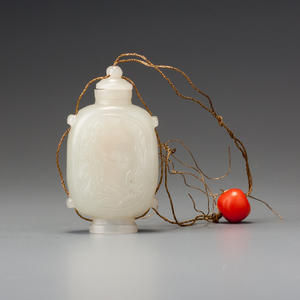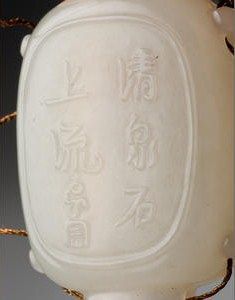An inscribed white nephrite snuff bottle. Probably Imperial, attributable to the palace workshops, Beijing 1720–1780
An inscribed white nephrite snuff bottle. Probably Imperial, attributable to the palace workshops, Beijing 1720–1780. Photo Bonhams
3.8cm high. Lot 53. Sold for HK$ 350,000
Treasury 1, no. 89
白玉王維詩句鼻煙壺
擬御製品,傳宮廷作坊製品,北京,1720~1780
An inscribed white nephrite snuff bottle
Flawless nephrite; not very well hollowed and with a deeply recessed foot; each side with an oval panel framed by a raised ridge, one carved with a scholar beneath a pine tree in a rocky landscape, the other with an inscription in relief draft script, of a line by the Tang poet Wang Wei, 'The clear spring flows above the rocks,' followed by the signature Zigang in relief seal script, each narrow side with two plain loops to hold a suspension cord which also threads through holes in either side of the foot and on either side of the finial of the original stopper, coming together at its top through a single hole
Probably Imperial, attributable to the palace workshops, Beijing 17201780
Height: 3.8 cm (4.41 cm including original stopper)
Mouth/lip: 0.51/0.95 and 1.00 cm (oval)
Stopper: nephrite; with integral collar, finial and 'cork'; original
Associated paraphernalia: modern cord and bead
Condition: Small chip to the stopper (where joined to the spoon); tiny chip and possible hair-line crack in footrim; otherwise, workshop condition
Provenance: Hugh M. Moss Ltd. (Hong Kong, 1992)
Published: Kleiner 1995, no. 52
Treasury 1, no. 89
Exhibited: British Museum, JuneOctober 1995
Cord loops on bronze vases are known from as early as the Han dynasty and there were certainly such vessels in the Imperial collections, providing a possible source of inspiration for this form; even the shape itself could have been taken from a Han bronze. Another possible source is the Japanese inro. We know that the inro was introduced into Beijing palace arts during the Yongzheng period. For a discussion of two Yongzheng jade bottles based on the inro form and two known palace enamel copies of inro bearing Yongzheng Imperial reign-marks, see Moss, Graham, and Tsang 1993, p. 85. This may have been the source of a group of Qianlong snuff bottles of flattened forms with various methods of stringing them on suspension cords at the narrow sides (see Friedman 1990, no. 69).
Apart from the form, several features allow an attribution to the palace workshops. The distinctive hollowing, which is well hollowed in the upper section of the bottle, but leaves a heavy base area, is typical of the Beijing palace workshops of the Qianlong era, as is the type of stopper and the integral nephrite 'cork'. The flat upper neck rim is also a standard palace feature, and the eccentric form with the deeply recessed foot are all associated with the court.
What is intriguing here, however, is that the style of carving is inspired by the seventeenth- and early eighteenth-century 'first phase' style of Suzhou carving, which is based on the works of the famous late-Ming artist Lu Zigang, whose name appears on this example. The way the style is interpreted, however, is quite unlike Suzhou workmanship from the early to mid-eighteenth century. The relief inscription is also less fluent than was common at Suzhou at the time, and a further telling point is the colour of the nephrite. Suzhou tended to favour a much whiter colour of nephrite for works of this kind, whereas the court used a great deal of this pale greenish-white colour. It is more likely that this bottle is a court product but copying the style of Suzhou, which was renowned throughout the empire by that time. This might have been more likely to happen during the first half of the century rather than during the later Qianlong reign when the emperor's distaste for certain elements of Suzhou style was established.
For a miniature bottle, it has extraordinary presence partly due to the unusual form and the quality of carving. Like the finest of miniatures in any field, it looks like a work that was made full size, without any of the constraints of its true size, and then somehow shrunk to its present dimensions. It also employs an extremely rare textural feature in the carving.
The surface relief is all polished to a higher sheen than the ground plane, which is matt. This is an unusual technique and one often used on seventeenth- and early eighteenth-century plaques carved at Suzhou, just to inject a necessary cautionary note into our attribution to the palace workshops.
There is a bit of scholarly wit in the carving: the characters on one side of the bottle are the second line in a couplet from a familiar poem by Wang Wei. The first line of that couplet, "The bright moon shines among the pines," is present on the other side of the bottle in the picture of a scholar beneath a pine tree.
Bonhams. 27 May 2012 10 a.m. Hong Kong. Snuff Bottles from the Mary and George Bloch Collection: Part V

/https%3A%2F%2Fprofilepics.canalblog.com%2Fprofilepics%2F1%2F0%2F100183.jpg)
/https%3A%2F%2Fstorage.canalblog.com%2F03%2F02%2F119589%2F96711876_o.jpg)
/https%3A%2F%2Fstorage.canalblog.com%2F11%2F31%2F119589%2F94773502_o.jpg)
/https%3A%2F%2Fstorage.canalblog.com%2F20%2F83%2F119589%2F94772815_o.jpg)
/https%3A%2F%2Fstorage.canalblog.com%2F26%2F72%2F119589%2F75604929_o.jpg)
/https%3A%2F%2Fstorage.canalblog.com%2F59%2F60%2F119589%2F26458628_o.jpg)






/http%3A%2F%2Fstorage.canalblog.com%2F90%2F99%2F119589%2F112019528_o.jpg)
/http%3A%2F%2Fstorage.canalblog.com%2F28%2F27%2F119589%2F96391842_o.jpg)
/http%3A%2F%2Fstorage.canalblog.com%2F43%2F72%2F119589%2F96391734_o.jpg)
/http%3A%2F%2Fstorage.canalblog.com%2F59%2F25%2F119589%2F96117222_o.jpg)